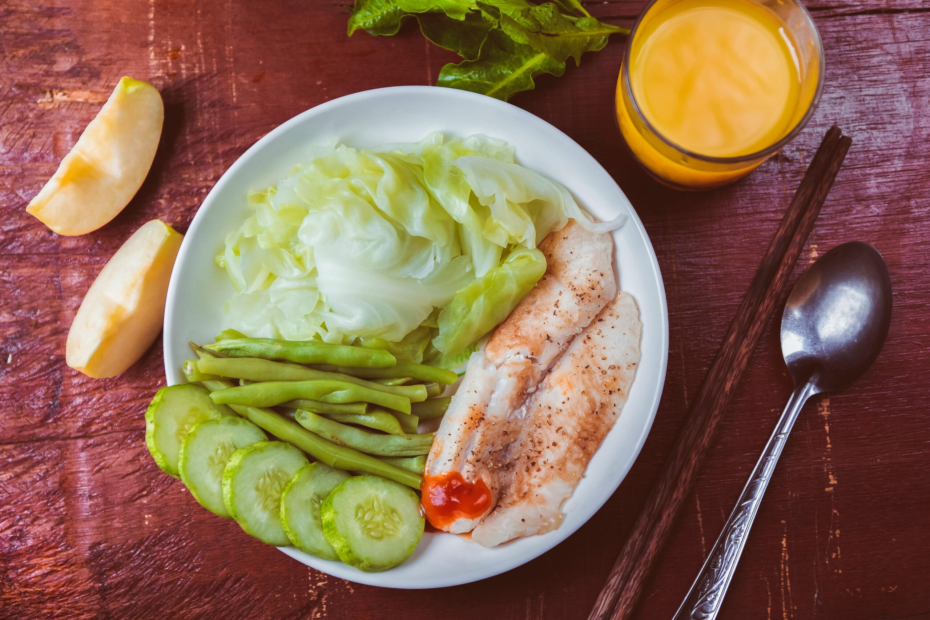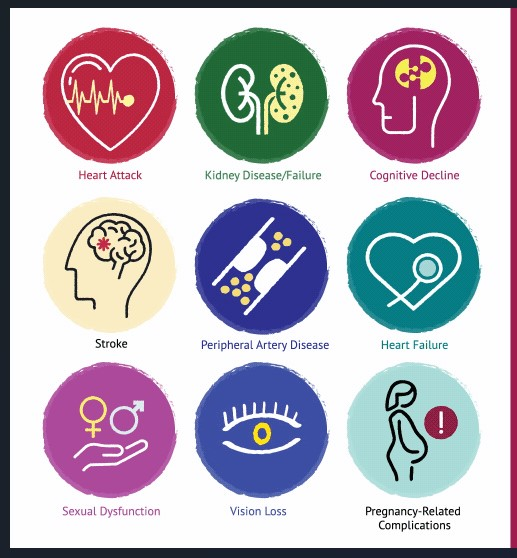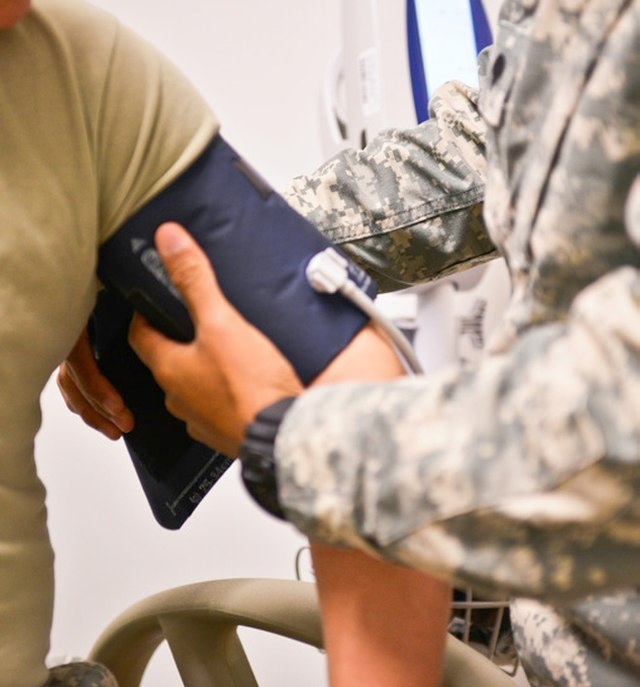DASH Diet to Lower Blood Pressure: The Complete 2025 Guide
You’re at your doctor’s office, and they’ve just told you your blood pressure is too high. They hand you a pamphlet about the “DASH diet” and suggest you try it before considering medication. You nod politely, but inside you’re thinking: what exactly is this diet, and does it really work?
The short answer is yes – the DASH diet works remarkably well. But there’s so much more to know about why it’s effective and how to make it work for you.
What Is the DASH Diet and Why Does It Work?

DASH stands for “Dietary Approaches to Stop Hypertension.” It was developed by the National Heart, Lung, and Blood Institute (NHLBI) over 20 years ago specifically to help people manage high blood pressure without medication.
Unlike many fad diets that focus on restriction, the DASH eating plan is all about abundance. You’re not cutting out entire food groups or counting every calorie. Instead, you’re filling your plate with nutrient-rich foods that naturally support healthy blood pressure.
The diet works because it targets the root causes of high blood pressure:
How DASH Lowers Your Blood Pressure:
The Research: How Well Does DASH Actually Work?
The evidence for the DASH diet is impressive. Multiple landmark studies have proven its effectiveness, with some showing blood pressure reductions as significant as many medications.
The Original DASH Study
The first major study involved 459 people with normal or slightly high blood pressure. Researchers tested three different eating plans:
- A typical American diet
- A typical American diet with extra fruits and vegetables
- The DASH eating plan
The results were remarkable: the DASH diet reduced systolic blood pressure by 5.5 mmHg and diastolic pressure by 3.0 mmHg in just 8 weeks. For people who started with high blood pressure, the drops were even bigger – 11.4 mmHg systolic and 5.5 mmHg diastolic.
The DASH-Sodium Trial
Researchers wanted to know if combining DASH with lower sodium would work even better. They were right. People following the DASH diet with low sodium intake saw their blood pressure drop by an average of 7.1 mmHg in those without hypertension and 11.5 mmHg in those with hypertension.
Recent Research: DASH for Diabetes
A June 2025 Johns Hopkins study found that adults with type 2 diabetes saw clinically meaningful blood pressure reductions when following a modified DASH diet with lower sodium – even while taking multiple blood pressure medications.
This is particularly important because people with diabetes often struggle with high blood pressure, and the combination significantly increases heart disease risk.
The Complete DASH Diet Eating Plan
So what exactly do you eat on the DASH diet? The beauty of this approach is its flexibility. Rather than giving you a rigid meal plan, DASH provides guidelines for different food groups.
Here’s what a 2,000-calorie DASH eating plan looks like:
| Food Group | Daily Servings | What Counts as One Serving | Key Benefits |
|---|---|---|---|
| Vegetables | 4-5 servings | 1 cup raw leafy greens, ½ cup cooked vegetables | Potassium, magnesium, fiber |
| Fruits | 4-5 servings | 1 medium fruit, ½ cup fresh/frozen fruit | Potassium, magnesium, fiber |
| Whole grains | 6-8 servings | 1 slice bread, ½ cup cooked rice/pasta | Energy, fiber, magnesium |
| Low-fat dairy | 2-3 servings | 1 cup milk/yogurt, 1.5 oz cheese | Calcium, protein |
| Lean protein | 6 oz or less | 3 oz cooked meat/poultry/fish | Protein, B vitamins |
| Nuts/seeds/beans | 4-5 per week | ⅓ cup nuts, 2 tbsp seeds, ½ cup cooked beans | Magnesium, protein, fiber |
| Fats and oils | 2-3 servings | 1 tsp vegetable oil, 1 tbsp salad dressing | Vitamin E, healthy fats |
Foods to Emphasize on DASH
When you’re building your DASH diet eating plan, focus on these powerhouse foods:
Vegetables (aim for variety and color):
- Dark leafy greens: spinach, kale, collard greens
- Colorful vegetables: bell peppers, carrots, tomatoes
- Cruciferous vegetables: broccoli, cauliflower, Brussels sprouts
- Potassium-rich options: sweet potatoes, beets, winter squash
Fruits (fresh, frozen, or dried without added sugar):
- Berries: blueberries, strawberries, raspberries
- Citrus fruits: oranges, grapefruits, lemons
- Potassium champions: bananas, cantaloupe, apricots
- Apples, pears, and grapes for fiber and antioxidants
Whole grains (choose unprocessed options):
- Brown rice, quinoa, and wild rice
- Whole wheat bread and pasta
- Oats, barley, and bulgur
- Whole grain cereals with no added sugar
Foods to Limit or Avoid
The DASH diet doesn’t ban foods entirely, but it does recommend limiting certain items that can raise blood pressure:
Foods to Limit
• Processed meats (deli meat, bacon, sausage)
• High-sodium foods (canned soups, frozen meals)
• Sugary drinks and desserts
• Full-fat dairy products
• Fried and fast foods
Smart Swaps
• Choose fresh or low-sodium canned vegetables
• Use herbs and spices instead of salt
• Pick lean proteins like chicken, fish, beans
• Snack on fruits and nuts instead of chips
• Drink water, herbal tea, or low-fat milk
Sample DASH Diet Meal Plans
Seeing how the DASH eating plan works in real life makes it much easier to follow. Here’s a sample day that hits all the DASH targets while keeping things delicious and practical:
Day 1: Complete DASH Menu
This sample day provides about 2,000 calories and stays within DASH sodium guidelines while delivering plenty of potassium, magnesium, calcium, and fiber.
Meal Prep Tips for DASH Success
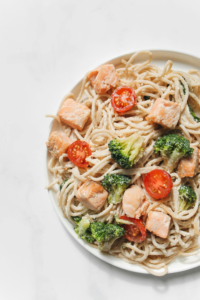
The key to sticking with any eating plan is making it convenient. Here are some practical strategies:
- Batch cook grains: Cook large batches of brown rice, quinoa, and oats on weekends
- Prep vegetables: Wash, chop, and store vegetables when you get home from grocery shopping
- Make freezer-friendly soups: Vegetable-based soups with beans freeze well and make quick meals
- Keep healthy snacks visible: Put fruit on the counter and cut vegetables in the fridge
- Plan your proteins: Grill or bake several chicken breasts at once for easy meal additions
The Sodium Factor: Why It Matters So Much
One of the biggest challenges people face with the DASH diet is managing sodium intake. The standard DASH plan recommends no more than 2,300mg of sodium daily, while the low-sodium version limits it to 1,500mg.
To put this in perspective, the average American consumes about 3,400mg of sodium daily – mostly from processed and restaurant foods.
Smart Sodium Strategies
Here’s how to keep sodium in check while following DASH:
When Shopping:
- Read nutrition labels and choose products with less than 140mg sodium per serving
- Look for “no salt added” or “low sodium” versions of canned goods
- Choose fresh or frozen vegetables over canned when possible
- Buy plain, unseasoned proteins and season them yourself
- here is a great guide as well check it out this ——-> the DASH accelerator
When Cooking:
- Use herbs, spices, lemon juice, and vinegar for flavor instead of salt
- Rinse canned beans and vegetables to remove excess sodium
- Make your own salad dressings and marinades
- Gradually reduce salt in recipes – your taste buds will adapt
When Eating Out:
- Ask for dressings and sauces on the side
- Choose grilled, baked, or steamed foods over fried
- Request no salt be added during cooking
- Skip the bread basket or choose plain bread over seasoned options
DASH Diet vs. Other Approaches: How It Compares
You might wonder how the DASH diet stacks up against other popular approaches to lowering blood pressure. Let’s look at the evidence:
| Approach | Blood Pressure Reduction | Time to See Results | Ease of Following |
|---|---|---|---|
| DASH Diet | 5-11 mmHg systolic | 2-8 weeks | Moderate |
| Low-sodium diet alone | 2-5 mmHg systolic | 2-4 weeks | Challenging |
| Mediterranean diet | 3-6 mmHg systolic | 3-12 weeks | Moderate to easy |
| Weight loss (10 lbs) | 5-10 mmHg systolic | 8-12 weeks | Challenging |
| Exercise (30 min daily) | 4-8 mmHg systolic | 4-8 weeks | Moderate |
What’s particularly powerful about DASH is that it works well in combination with other proven blood pressure management strategies. When you combine DASH with regular exercise and stress management, the blood pressure benefits often add up to more than any single approach alone.
Who Benefits Most from the DASH Diet?
While DASH can help almost anyone improve their blood pressure, certain groups tend to see particularly impressive results:
People with Prehypertension
If your blood pressure is in the 120-139/80-89 range, DASH can be incredibly effective at preventing progression to full hypertension. The PREMIER trial showed that people in this category could achieve normal blood pressure through DASH combined with lifestyle changes.
African Americans
Research shows that African Americans often respond particularly well to DASH. This population has higher rates of hypertension and tends to be more salt-sensitive, making DASH’s low-sodium approach especially beneficial.
People with Type 2 Diabetes
The recent Johns Hopkins research highlighted DASH’s effectiveness for people with diabetes. This is crucial because diabetes and high blood pressure together dramatically increase cardiovascular risk.
Older Adults
As we age, our blood pressure naturally tends to rise. DASH can be particularly helpful for older adults because it provides all the nutrients needed for healthy aging while addressing blood pressure concerns.
Making DASH Work in Real Life
The biggest challenge with any eating plan isn’t understanding what to do – it’s actually doing it consistently. Here are strategies to make DASH sustainable:
Start Gradually
Don’t try to overhaul your entire diet overnight. Pick one or two changes to focus on each week:
- Week 1: Add one extra serving of vegetables to lunch and dinner
- Week 2: Switch from refined grains to whole grains
- Week 3: Replace one meat meal with beans or lentils
- Week 4: Start reading sodium labels and choosing lower-sodium options
Focus on Addition, Not Restriction
Instead of thinking about what you can’t eat, focus on all the delicious foods you’re adding. When you fill your plate with vegetables, fruits, and whole grains, there’s naturally less room for less healthy options.
Make It Social
Get family members involved in DASH eating. Cook together, try new recipes, and make healthy eating a shared adventure rather than a solo struggle.
Plan for Challenges
Think ahead about situations that might derail your eating plan:
- Busy weeknights: Keep simple DASH-friendly frozen meals on hand
- Social events: Eat a small DASH snack before parties to avoid overindulging
- Travel: Pack nuts, fruit, and whole grain crackers for healthy snacking
- Cravings: Allow yourself small portions of favorite foods occasionally
Budget-Friendly DASH Eating
One common concern about DASH is cost. The good news is that this eating plan can actually save you money compared to buying processed foods and eating out frequently.
Money-Saving Tips
• Buy frozen fruits and vegetables
• Purchase grains and beans in bulk
• Shop seasonal produce
• Use dried herbs and spices
• Cook larger batches for leftovers
Affordable DASH Staples
• Dried beans and lentils
• Frozen vegetables and berries
• Oats and brown rice
• Canned fish (low-sodium)
• Seasonal fresh produce
Common Mistakes and How to Avoid Them
After working with many people following DASH, here are the most common pitfalls and how to avoid them:
Common Mistakes
• Trying to change everything at once
• Not reading sodium labels
• Giving up after one “imperfect” day
• Focusing only on restrictions
• Not planning meals ahead
Success Strategies
• Make one small change per week
• Learn to spot high-sodium foods
• View slip-ups as learning opportunities
• Celebrate foods you’re adding
• Prep ingredients on weekends
Beyond Blood Pressure: Other DASH Benefits
While DASH was designed specifically to lower blood pressure, research has uncovered many additional health benefits:
Heart Disease Prevention
Following DASH can reduce LDL (“bad”) cholesterol and decrease overall heart disease risk. The combination of increased fiber, healthy fats, and antioxidants supports cardiovascular health in multiple ways.
Diabetes Management
The emphasis on whole grains, fiber-rich foods, and limited added sugars helps stabilize blood sugar levels. This makes DASH particularly valuable for people with prediabetes or type 2 diabetes.
Weight Management
Many people naturally lose weight on DASH without trying. The high fiber content helps you feel full on fewer calories, while the focus on whole foods naturally reduces calorie intake.
Bone Health
DASH’s emphasis on calcium-rich dairy products and magnesium from vegetables and whole grains supports bone density, particularly important as we age.
Monitoring Your Progress
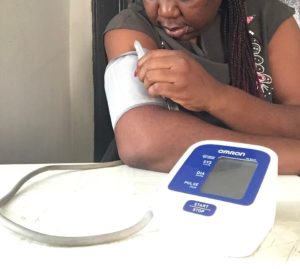
To see if DASH is working for you, it’s important to track your progress systematically:
Blood Pressure Tracking
Check your blood pressure regularly, ideally at the same time of day. Many pharmacies offer free blood pressure checks, or you can invest in a home monitor.
Keep a simple log noting:
- Date and time
- Blood pressure reading
- How long you’ve been following DASH
- Any medications you’re taking
- Stress levels or sleep quality
Other Health Markers
Consider tracking these additional indicators of health improvement:
- Energy levels throughout the day
- Sleep quality
- Mood and stress management
- Digestive health
- Weight (if weight loss is a goal)
When to Expect Results
One of the most encouraging aspects of DASH is how quickly it can start working:
Timeline of Benefits
- Week 1-2: You might notice better energy levels and improved digestion
- Week 2-4: Initial blood pressure improvements often become apparent
- Week 4-8: More significant blood pressure reductions, improved sleep
- Week 8-12: Maximum blood pressure benefits, potential weight loss
- Beyond 3 months: Long-term cardiovascular health improvements
The Future of DASH: Ongoing Research
Scientists continue to refine our understanding of how DASH works and how to make it even more effective. Current research areas include:
- Personalized DASH: Using genetic testing to customize the diet for individual responses
- DASH for specific populations: Studying effectiveness in different ethnic groups and age ranges
- Digital DASH support: Developing apps and tools to make following DASH easier
- Combination approaches: Testing DASH with other interventions like mindfulness or specific exercise programs
Making DASH a Lifestyle, Not a Diet
The most successful DASH followers don’t think of it as a temporary diet – they view it as a sustainable way of eating that supports their long-term health goals.
This mindset shift is crucial because the benefits of DASH are cumulative. The longer you follow it, the greater the protective effects on your cardiovascular system.
The Bottom Line: Is DASH Right for You?
The DASH diet to lower blood pressure has more scientific backing than virtually any other dietary approach to hypertension management. With consistent reductions of 5-11 mmHg in systolic blood pressure, it can be as effective as some medications.
DASH makes sense if you:
- Have high blood pressure or prehypertension
- Want to reduce your risk of heart disease
- Prefer food-based approaches to health improvement
- Are willing to make gradual, sustainable changes
- Want an eating plan supported by decades of research
The best part about DASH is that you’re not just lowering your blood pressure – you’re creating an eating pattern that supports optimal health in multiple ways. From better heart health to improved diabetes management to enhanced bone density, the benefits extend far beyond blood pressure numbers.
Start where you are, with what you can do today. Add an extra serving of vegetables to your dinner. Choose whole grain bread instead of white. Try a piece of fruit as an afternoon snack instead of chips.
These small changes, sustained over time, can add up to dramatic improvements in your health. The research is clear: the DASH diet eating plan works. Now it’s time to make it work for you.
References
- NHLBI, NIH. “NIH-supported DASH diet named ‘Best Heart-Healthy Diet’ and ‘Best Diet for High Blood Pressure’ in 2025.” January 2025.
- PMC. “DASH Diet: A Review of Its Scientifically Proven Hypertension Reduction and Health Benefits.”
- Johns Hopkins Medicine. “Study Finds Eating ‘DASH for Diabetes’ Lower-Sodium Diet Can Produce Clinically Meaningful Reduction in Blood Pressure for People with Type 2 Diabetes.” June 2025.
- NHLBI, NIH. “DASH Eating Plan.”
- New England Journal of Medicine. “A Clinical Trial of the Effects of Dietary Patterns on Blood Pressure.”
- NCBI Bookshelf. “DASH Diet To Stop Hypertension – StatPearls.” January 2023.
- PubMed. “Dietary Approaches to Stop Hypertension (DASH) Diet and Blood Pressure Reduction in Adults with and without Hypertension: A Systematic Review and Meta-Analysis.” September 2020.
- NHLBI, NIH. “Following the DASH Eating Plan.”
- Flavor365. “What to Eat on the DASH Diet: A Complete Food List.” August 2025.
- Cleveland Clinic. “DASH Diet: What It Is, Meal Plans and Recipes.” June 2025.
- Heart and Stroke Foundation. “The DASH Diet to lower high blood pressure.”
- National Kidney Foundation. “The Dash Diet for Kidney Disease Treatment.”
Medical Disclaimer
This article is for informational purposes only and doesn’t constitute medical advice. High blood pressure is a serious medical condition that requires professional supervision. Always consult with a qualified healthcare provider before making changes to your blood pressure management plan, starting new eating plans, or adjusting medications. Individual results may vary, and this information shouldn’t replace professional medical guidance.
Author Bio: The Remedy Verified Team translates complex metabolic science into clear, practical strategies for everyday health.
